 Click
below to view the pages for each family Click
below to view the pages for each family |
 Display/Hide All
Display/Hide All
 Chaiken
Family of Nezhin Chaiken
Family of Nezhin
 Chazanov
Family of Nezhin Chazanov
Family of Nezhin
 Fine
Family of Bialystok Fine
Family of Bialystok
 Geffen
Family of Vilkomir Geffen
Family of Vilkomir
 Goldberg
Family of Jablonka Goldberg
Family of Jablonka
 Katz/Hollander
Family Katz/Hollander
Family
 Zavelsky
Family of Glukhov Zavelsky
Family of Glukhov



| Click here
to learn more about our visit to the Majdanek Concentration Camp. |
 |
 |
| The Uprising -
dangerous enemies of the Great Reich. #1...from The Memorial
Route To The Struggle and Martyrdom of The Jews 1940-1943 |
Warsaw is an intregal part of our family
history. Not only did members of the Fajn family reside there,
but many of our ancestors passed through Warsaw on their way
to America or sadly, on their way to the death camps.
From Our Diary..."At 7:50PM,
we left St. Petersburg on the Polish Airlines, Lot, for Warsaw.
Entering the country was no problem and the Bristol Hotel was
an unexpected 5 star beautiful hotel. Everyone at the Hotel
was lovely to us. (See Photo #2)
Sunday, April 16, 1995
Mariola, our guide, arrived right after breakfast. She is charming
and very nice to be with, also very knowledgeable. We hired
a cab driver, as we had arranged to rent our car tomorrow, and
set out to visit some sights in Warsaw.
Our first stop was at The Heroes of the Ghetto Monument. It
was unveiled on April 19, 1948 on the fifth anniversary of the
uprising of the Warsaw Ghetto. It is a beautiful and impressive
monument and on the back is the sculpture showing the Jewish
people in route to the Ghetto, carrying their most important
possessions. In the sculpture you see a man carrying a Torah
and you also see a naked woman. There is a copy of this monument
at Yad Vashem in Israel and I seem to recall that there was
a great deal of controversy there about the naked woman. (See
Photo #3)
We next went to see Mila 18 and the monument atop the bunker.
The Plaque on the monument reads: "Bunker of Jewish Fighters,
Organizers and Leader, Mordechai Anielewicz." It was here
in this bunker that the leader and the resistance fighters died
when the bunker was blown up. These monuments are in the area
that was the Warsaw Ghetto. You do not get a feel for it at
all as all of the current buildings are post war. The only remains
of the original Ghetto is a small section of the brick wall,
perhaps thirty feet long, that was part of one of the boundaries.
(See Photos #4 and #5)
Next stop was Umschlagplatz. On one side of the street is where
SS Headquarters were and on the other side a beautiful memorial.
It was on this spot that the Jews of the Warsaw Ghetto were
taken to wait to board the trains to Treblinka. (See Photo #6)
On the wall of the memorial are inscribed 400 first names of
Jewish people. The first names are used as there would never
have been enough room to inscribe all of the last names. (See
Photo #7)
One has many thoughts while visiting these places and memorials.
Alan said he felt anger. I feel several things. First, I keep
recalling the pictures of these poor people walking to the Ghetto
and trains with their meagerly allowed possessions. Hopefully
they did not know where they were going. I too feel anger, but
I also feel very close to our ancestors and fellow Jews who
were put through these indignation's. I also feel resentment
that more is not made of the Holocaust here in Warsaw. Perhaps
it is, but I have not seen what I would have expected today.
I cannot find a guide book that describes the Jewish memorials
and sites. Again, I must admit that I feel, perhaps selfishly,
that thank God my grandparents immigrated to the U.S. We could
have been in Poland or Russia very easily.
The last of the Jewish sites we visited was the orphanage run
by Janusz Korlzhk (Hirsh Goldsmith). This orphanage was within
the Ghetto and when the children were sent to Treblinka, Goldsmith
would not leave them alone and went with them. They were all
killed in Treblinka. (See Photo #8)
On Tuesday we will be visiting the Jewish Historical Society
and I hope there I will find the feeling of preservation of
the Jewish people that I am looking for. Warsaw is a much newer
looking city than St. Petersburg. It is very clean and pleasant.
As today is Easter Sunday it is very quiet. There are many old
and new buildings. The apartment houses are not as box like
as in St. Petersburg. The new ones are being built with more
charm and character to them.
We visited Lazienki Park with the monument to Chopin. It is
an interesting sculpture as you see Chopin sitting and next
to him the branches of a Willow Tree that form a hand. In another
part of the park we saw Belvedere that is the equivalent of
our White House. It is very good looking, but the facade is
peeling. Also, in the park is the Palace, ponds and Peacocks.
It is very beautiful and must be even nicer when Spring comes.
Though nothing is really in bloom here, it is much greener and
brighter than St. Petersburg.
Our last stop for the day was to see the Parliament Building,
then back to the hotel. There is a great deal to absorb here
and to think about. Dinner at our hotel, The Bristol, and early
to bed. Monday, April 17, 1995 We had our car delivered to the
hotel at 9:AM and set out for Lublin. It took about two hours
to arrive in Lublin and the Majdanek Concentration Camp.
Tuesday, April 18, 1995. Our luck seems to still be holding
out for finding information. We started the day by going to
The Jewish Cemetery "Geisa," in Warsaw. (See Photo
#9)
We were met by the director Boleslaw Szenicer who had the list
of tombstones ready for the family names Mariola had given him.
What a surprise. Numerous Fajn's, Scheresjchewsky's and Peretz
tombstones. The cemetery is amazing in that it was established
in 1806, is still in existence today and is being used for new
burials. It needs a tremendous amount of work. There are over
200,000 graves and tombstones there and it is fascinating. Through
Miriam Weiner's help, the director now has a computer. He has
45,000 names from tombstones entered which enables him to look
up these names and find where the graves are located.
We started with our list of about thirty names. After I saw
how long it took to find the first grave, I figured we would
have to stay in the cemetery for two weeks to find all of them.
We arranged to have Boreslaw photograph the graves for us and
send them along with the translation to us at home. What a thrill
for me to find the grave there of Helen Fajn, sister of my great
grandfather, Leon Fine.
We also saw the beautiful monument where three writers, Denetson,
An-ski and Peretz are buried. These three writers were friends
and relatives of the Dennison and Peretz families of New Jersey.
(Cousins of my mother) (See Photo #`11)
The cemetery needs a great deal of work. It is overgrown with
weeds and broken trees. They have started a foundation to raise
money for repairs, but will need volunteers to do the cleanup
and repairs. I could have spent many hours here. The tombstones
and inscriptions were fascinating, and incredible to me that
so many old ones are still there. (See Photo #10)
Next stop after the cemetery was The Jewish Historical Institute.
Among other records are books with names of Holocaust survivors
with additional information on each person. Again, we were lucky
and came away with listings for several Fajn's, Golumbek's (Alan's
father's family), Scherejshewsky's and even some Zavelsky's.
These names will require some work but I know some will tie
in to our family trees. Finding these names was very exciting
for me.
We went to have lunch at a kosher restaurant, but found it closed
due to Passover. We then visited the Nozyk Synagogue. (See Photos
#13 and #14) The Synagogue was destroyed during the war and
rebuilt. It is fairly simple, but very impressive.
Off to "Old Town" which is charming and how I picture
old Poland to look. All reconstructed, but well done with cobblestone
streets and small beautiful buildings. (See Photo #12) Late
lunch at believe it or not Pizza Hut and then that was it for
the day. Very fascinating. We leave for Ukraine tomorow." |
|
|
 |
| #2..The Bristol
Hotel in the early 1900s. It has been completely redone. |
 |
| #3..Heros
Of The Ghetto Monument...Photo 1995 |
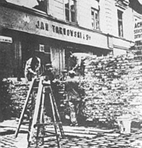 |
| #4...Jews
building the Ghetto wall in 1940 |
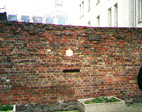 |
| #5...Remains
of the Warsaw Ghetto Wall...Photo1995 |
 |
| #6...Where
trains departed for Treblinka...Photo 1995 |
 |
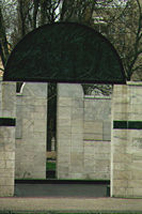 |
| #7...Memorial
wall at Umschlagplatz where first names are inscribed and the entrance
to the memorial...Photos 1995 |
 |
| #8...The
orphanage run by Janusz Korlzhk (Hirsh Goldsmith). This orphanage
was within the Ghetto. |
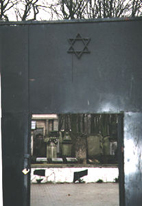 |
| #9...The
entrance to the Warsaw Jewish Cemetery...Photo 1995 |
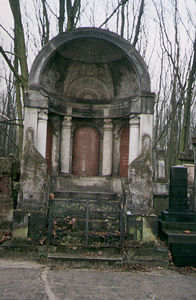 |
| #11...
Monument where Denetson, An-ski and Peretz, three famous writers are
buried in the Warsaw Jewish Cemetery...Photo 1995, |
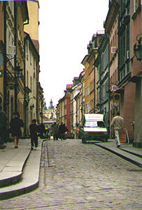 |
| #12...The
"old town" in Warsaw...Photo 1995 |
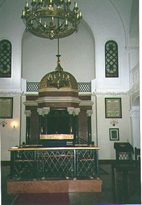 |
| #13...The
Bema in the Nozyk Synagogue...Photo 1995 |
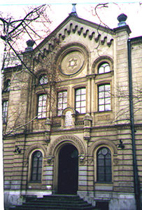 |
| #13...The
outside of the Nozyk Synagogue in Warsaw,,,Photo 1995 |
|








